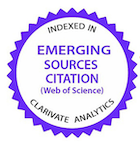Efeito de diferentes filmes plásticos dupla face sobre características quimíco-fermentativas da silagem de milho
DOI:
https://doi.org/10.1590/1809-6891v22e-66770Resumo
O objetivo deste trabalho foi avaliar a eficiência de diferentes filmes plásticos dupla face sobre as características quimiofermentativas, digestibilidade da matéria seca, estabilidade aeróbica, perdas físicas e de matéria seca de silagens de milho armazenadas em silos trincheira. O delineamento experimental utilizado foi inteiramente casualizado, compostos por três tratamentos: DF110µm - polietileno dupla face com espessura de 110 µm; DF200µm - polietileno dupla face com espessura de 200 µm; e DFBO - película impermeável ao oxigênio composta de polietileno dupla face com espessura de 80 µm sobreposta a uma película de poliamida translúcida a vácuo com espessura de 20 µm. O uso do filme DF200µm aumentou em 4,58% a digestibilidade ruminal da matéria seca e reduziu em 3,1 °C a temperatura da silagem, assim como as perdas físicas da silagem de milho foram reduzidas em 118,9 g kg-1 da MS pela utilização do DFBO e 95 g kg-1 da MS com o DF200µm, o DFBO apresentou a maior estabilidade aeróbica (127 horas) da silagem de milho. O uso de filme DF200μm e DFBO é recomendado para conservação de silagem de milho em silos do tipo trincheira.
Palavras-chave: Barreira de oxigênio. Digestibilidade da matéria seca. Estabilidade aeróbica. Perdas de matéria seca. Poliamida.
Downloads
Referências
Oliveira CA, Millen DD, Survey of the nutritional recommendations and management practices adopted by feedlot cattle nutritionists in Brazil. Animal Feed Science Technology. 2014;197: 64-75. English. Available in: https://doi.org/10.1016/j.anifeedsci.2014.08.010
Silva MSJD, Jobim CC, Poppi EC, Tres TT, Osmari MP. Production technology and quality of corn silage for feeding dairy cattle in Southern Brazil. Revista Brasileira de Zootecnia. 2015; 44(9): 303-313. English. Available in: https://doi.org/10.1590/S1806-92902015000900001
Borreani G, Tabacco E, Cavallarin L. A new oxygen barrier film reduces aerobic deterioration in farm-scale corn silage. Journal of Dairy Science. 2007; 90(10): 4701-4706. English. Available in: https://doi.org/10.3168/jds.2007-0310
Borreani G, Tabacco E. Improving corn silage quality in the top layer of farm bunker silos through the use of a next generation barrier film with high impermeability to oxygen. Journal Dairy Science. 2014; 97(4): 2415-2426. English. Available in: https://doi.org/10.3168/jds.2013-7632
Ferraretto LF, Shaver RD. Effects of whole-plant corn silage hybrid type on intake, digestion, ruminal fermentation, and lactation performance by dairy cows through a meta-analysis. Journal of Dairy Science. 2015; 98(4): 2662-2675. English. Available in: https://doi.org/10.3168/jds.2014-9045
Neumann M, Leão GFM, Askel EJ, Marafon F, Figueira DN, Poczynek M. Sealing type effect on corn silage quality in bunker silos. Ciência Rural. 2017; 47(5): 1-6. English. Available in: https://doi.org/10.1590/0103-8478cr20160643
Neumann M, Leão GFM, Santos LC, Marafon, F, Askel EJ. Double seal in corn silage in confined cattle production. Revista de Ciências Agroveterinárias (Journal of Agroveterinary Sciences). 2018; 17(1): 100-106. Portuguese. Available in: https://doi.org/10.5965/223811711712018100
Bernardes, TF. Advances in Silage Sealing. In: Da Silva T, Santos EM. Advances in Silage Production and Utilization. 1 ed. Rijeka, Croatia: InTech; 2016. p. 53-62. English. Available in:(https://www.intechopen.com/books/advances-in-silage-production-and-utilization/advances-in-silage-sealing).
Wilkinson JM, Fenlon JS. A meta-analysis comparing standard polyethylene and oxygen barrier film in terms of losses during storage and aerobic stability of silage. Grass and Forage Science. 2014; 69(3): 385–392. English. Available in: https://doi.org/10.1111/gfs.12087
Pott CA, Müller MML, Bertelli PB. Green manuring as an agroecological alternative for the recovery of soil fertility. Revista Ambiência. 2007; 3(1): 51-63. Portuguese. Available in: https://revistas.unicentro.br/index.php/ambiencia/article/view/300/412
Brazilian Society of Soil Science. State Center Paraná. Fertilization and Liming Manual for the State of Paraná. – Curitiba:SBCS/NEPAR; 2017. 301p. Portuguese. Available in:https://www.sbcs.org.br/index.php?route=product/product&product_id=136
AOAC Association of Official Analytical Chemists. Official Methods of Analysis of the Association of Official Analytical Chemists, 16th edition, Association of Official Analytical Chemists. Arlington, V.A., U.S.A. 1995. English. Available in: https://www.aoac.org/journal-of-aoac-international/
Neumann M, Sandini IE, Ost PR, Falbo MK, Lustosa SBC, Pellegrini LG. feedlot performance of steers fed with silages of corn and of sorghumassociated with three levels of concentrate. Revista Brasileira de Milho e Sorgo, Sete Lagoas. 2007; 6(3): 365-378. Portuguese. Available in: https://doi.org/10.18512/1980-6477/rbms.v6n03p%25p
Cherney JH, Cherney DJR. Assessing Silage Quality. In: Buxton DR, Muck RE, Harrison HJ. Silage Sci-ence and Technology. 4nd ed. American Society of Agronomy, Inc., Crop Science Society of America, Inc., Soil Science Society of America, Inc. 2003. p. 141-198. English. Available in: (https://acsess.onlinelibrary.wiley.com/doi/pdf/10.2134/agronmonogr42.c4)
Silva DJ, Queiroz AC. Análise de alimentos, métodos químicos e biológicos. 3ª reimpressão. Universidade Federal de Viçosa; 2009. 235p. Portuguese. Available in: https://www.editoraufv.com.br/produto/analise-de-alimentos-3-edicao/1108830
Van Soest PJ, Robertson JB, Lewis BA. Methods for dietary fiber, neutral detergent fiber, and nonstarch polysaccharides in relation to animal nutrition. Journal of Dairy Science. 1991; 74(10): 3583-3597. English. Available in: https://doi.org/10.3168/jds.S0022-0302(91)78551-2
Goering HK, Van Soest PJ, Forage fiber analysis: apparatus reagents, procedures and some applications. Agricultural Handbook. 1970. p.379. English. Available in: https://books.google.com.br/books?hl=pt-BR&lr=&id=2BjFvEonaHoC&oi=fnd&pg=PA1&dq=Goering+HK,+Van+Soest+PJ,+Forage+fiber+analysis:+apparatus+reagents,+procedures+and+some+applications.+Agricultural+Handbook.+1970.+p.379.+&ots=mNWMXpHJqX&sig=eLL9DhSM6Mm58bIGBv-QXhkynIs#v=onepage&q&f=false
Bolsen KK, Ashbell G, Weinberg ZG. Silage fermentation and silage additives-Review. Asian-Australasian journal of animal sciences. 1996; 9:483-494. English. Available in: https://doi.org/10.5713/ajas.1996.483
Nocek JE. In situ and other methods to estimate ruminal protein and energy digestibility: a review. Journal of Dairy Science. 1988; 71(8): 2051-2069. English. Available in: https://doi.org/10.3168/jds.S0022-0302(88)79781-7
Price JDA. Modification of the Barker – Summer son Method for the Determination of Lactic Acid. Afialyst. 1969; 94(1125): 1151-1152. English. Available in: https://doi.org/10.1039/AN9699401151
Kung Junior L, Robinson JR, Ranjit NK, Chen JH, Golt CM, Pesek JD, Microbial populations, fermentation end-products, and aerobic stability of corn silage treated with ammonia or a propionic acid-based preservative. Journal of Dairy Science. 2000; 83(7): 1479-1486. English. Available in: https://doi.org/10.3168/jds.S0022-0302(00)75020-X
Weinberg ZG, Shatz O, Chen Y. Effect of lactic acid bacteria inoculants on in vitro digestibility of wheat and corn silages. Journal of Dairy Science. 2007; 90(10): 4754-4762. English. Available in: https://doi.org/10.3168/jds.2007-0176
Taylor CC, Kung Junior L. The effect of Lactobacillus buchneri 40788 on the fermentation and aerobic stability of high moisture corn in laboratory silos. Journal of Dairy Science. 2002; 85(6): 1526-1532. English. Available in: https://www.journalofdairyscience.org/article/S0022-0302(02)74222-7/pdf
SAS Institute. Sas/Stat User’sguide:statistics, version 6. 4.ed. North Caroline, Version 2. Cary (NC): SAS Insitute Inc., 1993. 943p. English. Available in: (https://www.ncbi.nlm.nih.gov/books/NBK7244/)
Machado, J. Filmes de vedação na conservação de silagem de milho para bovinos de corte em terminação. Maringá, 34 f. Dissertação (Mestrado) - Programa de Pós Graduação em Zootecnia, Produção Animal, Universidade Estadual de Maringá, Maringá, 2019. Portuguese. Available in: (http://sites.uem.br/ppz/trabalhos-de-conclusao/dissertacoes/2019/juliana-machado.pdf);(https://sucupira.capes.gov.br/sucupira/public/consultas/coleta/trabalhoConclusao/viewTrabalhoConclusao.jsf?popup=true&id_trabalho=6994113)
Daniel JLP, Bernardes TF, Jobim CC, Schmidt P, Nussio LG. Production and utilization of silages in tropical areas with focus on Brazil. Grass and Forage Science. 2019; 74(2): 188-200. English. Available in: https://doi.org/10.1111/gfs.12417
Bernardes TF, Nussio LG, Amaral RC. Top spoilage losses in maize silage sealed with plastic films with different permeabilities to oxygen. Grass and Forage Science. 2012; 67(1); 34–42. English. Available in: https://doi.org/10.1111/j.1365-2494.2011.00823.x
Bernardes TF, Daniel JLP, Adesogan AT, Mcallister TA, Drouin P, Nussio LG, Huhtanen P, Tremblay GF, Bélanger G, Cai Y. Silage review: Unique challenges of silages made in hot and cold regions. Journal of dairy science. 2018; 101(5): 4001-4019. English. Available in: https://doi.org/10.3168/jds.2017-13703
Borreani G, Dolci P, Tabacco E, Cocolin L. Aerobic deterioration stimulates outgrowth of spore-forming Paenibacillus in corn silage stored under oxygen-barrier or polyethylene films. Journal Dairy Science. 2013; 96(8): 5206–5216. English. Available in: https://doi.org/10.3168/jds.2013-6649
Gallo A, Guibert G, Frisvad JC, Bertuzzi T, Nielsen KF. Review on mycotoxin issues in ruminants: occurrence in forages, effects of mycotoxin ingestion on health status and animal performance and practical strategies to counteract their negative effects. Toxins. 2015; 7(8): 3057-3111. English. Available in: https://doi.org/10.3390/toxins7083057
Kleinschmit DH, Kung Junior L. A Meta-Analysis of the Effects of Lactobacillus buchneri on the Fermentation and Aerobic Stability of Corn and Grass and Small-Grain Silages. Journal of Dairy Science. 2006; 89(10): 4005 – 4013. English. Available in: https://doi.org/10.3168/jds.S0022-0302(06)72444-4
Kung Junior L, Shaver RD, Grant RJ, Schmidt RJ. Silage review: Interpretation of chemical, microbial, and organoleptic components of silages. Journal of dairy Science. 2018; 101(5): 4020-4033. English. Available in: https://doi.org/10.3168/jds.2017-13909
Daniel JLP, Capelesso A, Cabezas‐Garcia EH, Zopollatto M, Santos MC, Huhtanen P, Nussio LG. Fibre digestion potential in sugarcane across the harvesting window. Grass and Forage Science. 2014; 69(1); 176-181. English. Available in: https://doi.org/10.1111/gfs.12044
Yoshii T, Asanuma N, Hino T. Effect of ethanol on nitrate and nitrite reduction and methanogenesis in the ruminal microbiota. Animal Science Journal. 2005; 76(1): 37-42. English. Available in: https://doi.org/10.1111/j.1740-0929.2005.00235.x
Daniel JLP, Amaral RC, Neto AS, Cabezas-Garcia EH, Bispo AW, Zopollatto M, Cardoso TL, Spoto MHF, Santos FAP, Nussio LG. Performance of dairy cows fed high levels of acetic acid or ethanol. Journal of Dairy Science. 2013; 96(1): 398-406. English. Available in: https://doi.org/10.3168/jds.2012-5451
Kim SC, Adesogan AT. Influence of ensiling temperature, simulated rainfall, and delayed sealing on fermentation characteristics and aerobic stability of corn silage. Journal of Dairy Science. 2006; 89(8): 3122-3132. English. Available in: https://doi.org/10.3168/jds.S0022-0302(06)72586-3
Amaral RC, Santos MC, Daniel JLP, Sá Neto A, Bispo AW, Cabezas-Garcia EH, Nussio LG. The influence of covering methods on the nutritive value of corn silage for lactating dairy cows. Revista Brasileira de Zootecnia. 2014; 43; 471–478. English. Available in: https://doi.org/10.1590/S1516-35982014000900003
Pahlow G, Muck RE, Driehuis F, Elferink SJWHO, Spoelstra SF. Microbiology of ensiling. Agronomy. 42; 31-94. English. Available in: https://doi.org/10.2134/agronmonogr42.c2
Wang K, Uriarte ME, Li SC, Rich K, Banchero C, Bu DP, Wilkinson JM, Bolsen KK. Effect of type of underlay film on fermentation profile, nutritional quality and estimated loss of organic matter in the outer layer of whole‐plant maize ensiled in large bunker silos. Grass and Forage Science. 2017; 72(4): 772-776. English. Available in: https://doi.org/10.1111/gfs.12283
Tabacco E, Righi F, Quarantelli A, Borreani G. Dry matter and nutritional losses during aerobic deterioration of corn and sorghum silages as influenced by different lactic acid bacteria inocula. Journal of Dairy Science. 2011; 94(3): 1409-1419. English. Available in: https://doi.org/10.3168/jds.2010-3538
Hoffman PC, Combs DK. Molds and mycotoxins in corn silage and high moisture corn. Part I. Managing aerobic stability. Department of Dairy Science, University of Wisconsin-Madison, 2009. English. Available in: http://dysci.wisc.edu/uwex/brochures/brochures/hoffmold.pdf
Pitt RE, Muck RE. A diffusion model of aerobic deterioration at the exposed face of bunker silos. Journal of Agricultural Engineering Research, 1993; 55(1): 11-26. English. Available in: https://doi.org/10.1006/jaer.1993.1029
Wilkinson JM, Davies DR. The aerobic stability of silage: key findings and recent developments. Grass and Forage Science. 2013; 68(1): 1-19. English. Available in: https://doi.org/10.1111/j.1365-2494.2012.00891.x
Borreani G, Tabacco E. Plastics in animal production, In: ORZOLEK, M. (Ed.). A Guide to the Manufacture, Performance, and Potential of Plastics in Agriculture. 9nd ed. Amsterdam: Elsevier Ltd., 2017. p. 145–185. English. Available in: https://books.google.com.br/books?hl=ptBR&lr=&id=HpmpDQAAQBAJ&oi=fnd&pg=PP1&dq=+Plastics+in+animal+production,+In:+ORZOLEK,+M.+(Ed.).+A+Guide+to+the+Manufacture,+Performance,+and+Potential+of+Plastics+in+Agriculture.+9nd+ed.+Amsterdam:+Elsevier+Ltd.,+2017.+p.+145%E2%80%93185.+&ots=gGIoHSxcY5&sig=dO_XqgFvR6WzMEvV2m-GwFqLKek#v=onepage&q&f=false
Snell HGJ, Oberndorfer C, Lücke W, Van Den Weghe HFA. Effects of the colour and thickness of polyethylene film on ensiling conditions and silage quality of chopped maize, as investigated under ambient conditions and in mini‐silos. Grass and Forage Science. 2002; 57(4): 342-350. English. Available in: https://doi.org/10.1046/j.1365-2494.2002.00334.x
Borreani G, Tabacco E. Low permeability to oxygen of a new barrier film prevents butyric acid bacteria spore formation in farm corn silage. Journal of Dairy Science. 2008; 91(11): 4272-4281. English. Available in: https://doi.org/10.3168/jds.2008-1151
Rabelo CHS, Rezende AV, Nogueira DA, Rabelo FHS, Senedese SS, Vieira PF, Barbolsa LA, Carvalho A. Losses fermentative and aerobic stability of corn silages inoculated with lactic acid bacterial in different maturity stages. Revista Brasileira de Saúde e Produção Animal. 2012; 13(3); 656-668. English. Available in: https://doi.org/10.1590/S1519-99402012000300006
Lima EM, Jayme DG, Silva FCO, Micheli PHF, Cortes IHG, Anjos GVS, Silva NTA, Ottoni D. Aerobic deterioration of silages. Electronic Journal Nutritime. 2015; 12(2): 3996-4003. English. Available in: https://www.nutritime.com.br/arquivos_internos/artigos/ARTIGO299.pdf
Downloads
Publicado
Como Citar
Edição
Seção
Licença
Copyright (c) 2021 Ciência Animal Brasileira

Este trabalho está licenciado sob uma licença Creative Commons Attribution 4.0 International License.
Autores que publicam nesta revista concordam com os seguintes termos:
- Autores mantém os direitos autorais e concedem à revista o direito de primeira publicação, com o trabalho simultaneamente licenciado sob a Licença Creative Commons Attribution que permite o compartilhamento do trabalho com reconhecimento da autoria e publicação inicial nesta revista.
- Autores têm autorização para assumir contratos adicionais separadamente, para distribuição não-exclusiva da versão do trabalho publicada nesta revista (ex.: publicar em repositório institucional ou como capítulo de livro), com reconhecimento de autoria e publicação inicial nesta revista.
- Autores têm permissão e são estimulados a publicar e distribuir seu trabalho online (ex.: em repositórios institucionais ou na sua página pessoal) a qualquer ponto antes ou durante o processo editorial, já que isso pode gerar alterações produtivas, bem como aumentar o impacto e a citação do trabalho publicado (Veja O Efeito do Acesso Livre).






























